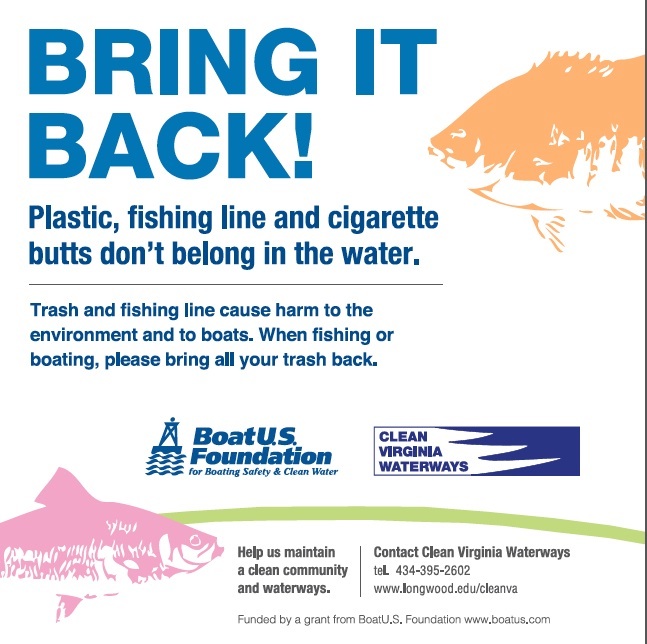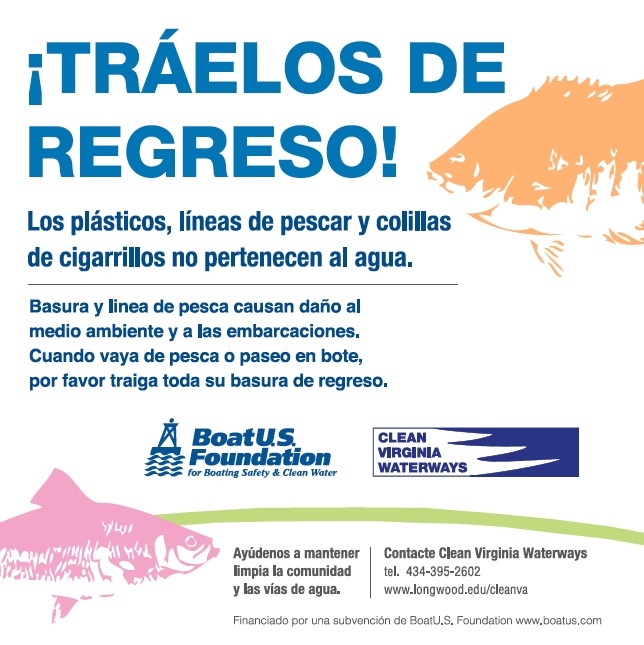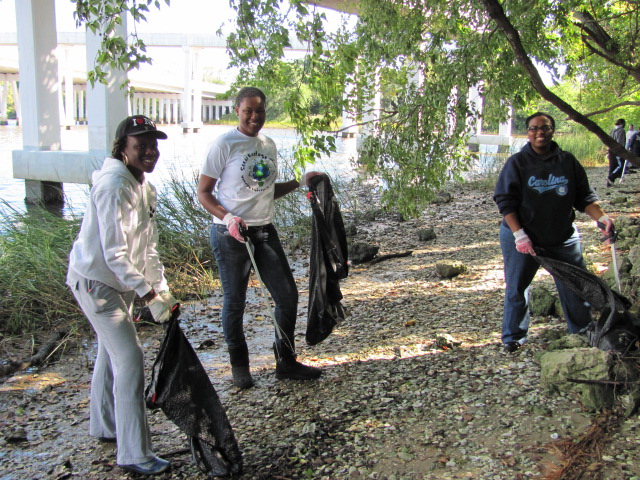Longwood University Water Quality Monitoring Program
Monitoring the Appomattox River and its Tributaries since 1999 in conjunction with Clean Virginia Waterways
The Longwood Universtiy Water Quality Monitoring Program, founded in 1999, is a project of Longwood
University, Dept. of Biological and Environmental Sciences, and Clean Virginia Waterways. It
has received funding from grants from the Virginia Environmental Endowment
and the Virginia Department of Environmental Quality (Citizen Monitoring Grant). It receives additional support from Longwood University. Longwood's Department of Biological and Environmental Sciences BES provides lab space and much of the necessary equipment (autoclave, fume hood, etc.) and glassware. This program has offered students valuable research opportunities in aquatic microbiology, as well as community/ citizen water monitoring programs.
NOTE: This program was originally called the Appomattox River Water Quality Monitoring Program. The name was changed when we started monitoring the creeks around Hull Springs Farm in Westmoreland County, VA.
Our Goals: 1. Promote citizen participation in river monitoring; train citizen and student volunteers in water quality monitoring 2. Increase the quality, quantity and scope of monitoring of water quality parameters in the Appomattox River watershed. 3. Establish a sustainable network of partners. 4. Provide regional leadership and serve as a "clearinghouse" of information water quality monitoring in the Appomattox River watershed. 5. The data collected will form a basis for long-term assessments of tributaries in the watershed. 6. Educate students from Longwood University (and other interested students) on water quality issues.
|
 Longwood students collect samples from a stormwater management pond on the campus. Longwood students collect samples from a stormwater management pond on the campus. |
7. Publicize volunteer water quality monitoring and related issues in order to increase citizen awareness on water quality issues. 8. Distribute the research results to local, state and federal decision makers for inclusion in watershed assessments, including Virginia's water quality reports. |
In the field and in the lab, Longwood students gain experience in water quality testing. |
Need
for this program:
The Appomattox River drains 1,023,851 acres of agricultural, rural residential
land and urban land to the James River then to the Chesapeake
Bay and ultimately to the Atlantic Ocean. The confluence of the James and Appomattox Rivers is at Hopewell, Virginia. The
1,598 square mile Appomattox River basin drains portions of 12 counties in
the Piedmont, several of which are included in this project's area of study.
Several of the watersheds within the Appomattox River Basin have been identified by Virginia's Department of Conservation and Recreation and the Department of Environmental Quality as having water quality impairments. Impaired streams in the Appomattox River basin include: Winterpock Creek, Winticomack Creek, Flat Creek, Nibbs Creek (which flows into Flat Creek), Deep Creek, Sandy River, Briery Creek, and Saylers Creek. Various Virginia Watershed Assessment Reports have identified pollution from animals and agriculture activities as possible sources of these impairments. One of the segments identified in Virginia's Impaired Waters list is a stretch of the Appomattox River.
Possible water quality problems experienced by the Appomattox River include forestry site-prep and harvesting erosion, agricultural erosion, and nonpoint pollution from agriculture and other sources. Targeted nutrient, bacterial, and organic chemical monitoring is necessary to delineate the extent of these problems, and to understand the causes and sources. By exploring the extent of the impairment of the Appomattox River, and understanding the factors that affect the quality of the river and its tributaries, we can take steps to restore the waterway. Continuous biological and chemical monitoring will also establish firm baseline data, necessary in a part of Virginia where the application of biosolids (processed human waste) and the expansion of factory farms (swine and poultry) are debated.
|
Parameters
we monitor: Local
Impact: |
 |
About Our Program: Why test for E. coli? Direct testing for pathogens (viruses, bacteria and protozoans that can cause disease) is impractical and prohibitively expensive. Instead, monitoring for pathogens uses "indicator" species—so called because their presence indicates that fecal contamination of water may have occurred. Coliform bacteria live in the lower intestines of mammals and other animals and are present in high concentrations (10-100 million of E. coli per gram fecal matter). These bacteria are normally prevalent in the intestines and wastes of warm-blooded animals, including wildlife (deer, geese, raccoons), farm animals (swine, cattle, poultry), pets and humans. |
The presence of these bacteria in waterways can signal contamination by sewage. Thus, coliform bacteria serve as fecal indicators, and their presence in high numbers indicate that disease-causing pathogens could also be present. The indicator bacteria themselves are not usually pathogenic. The CVW/Longwood program, like the state environmental quality program, tests water for the presence of fecal coliforms and E. coli.
Bacteria normally inhabit streams and rivers as an integral part of the food web (contributing to decomposition processes and to the food chain). Human activities may introduce pathogenic bacteria to the system. Of greatest concern to public health is the introduction of human and agricultural animal fecal waste.
The program found many streams around Farmville, VA occasionally or regularly have elevated levels of fecal coliform. These streams include the Appomattox River, Green Creek, Angola Creek, Saylers Creek, and Buffalo Creek. Many of these polluted stream segments (which the state calls "impaired") are already on the state's list of impaired waters. In 2016, we started monitoring the creeks around Hull Springs Farm in Westmoreland County, VA.
Sources of bacterial contamination include surface runoff from livestock congregation areas, inefficient septic systems, fecal waste from pets, storm water from streets and parking lots, sewage sludge, and untreated sewage discharge. Wildlife and waterfowl also add bacteria to waterways, and can be the dominant source of fecal coliform bacteria in some areas.
Uses of the Data:
1. Virginia Department of Environmental Quality (DEQ) may use the data to list and delist impaired waters on the 303(d) Impaired Waters List
2. Virginia DEQ may use the data to identify sources of pollution that may help in Total Maximum Daily Load (TMDL) development
3. Identify sources of pollution that may help the Town of Farmville solve the E. coli problem in Gross Creek (which drains most of the town).
4. Track progress of TMDL or other restoration activities
5. Identify waters for future monitoring by DEQ
6. Educating the community on local impacts to water quality and land use activities
Partners:
Funding: Funding to start this program was received from the Virginia Environmental Endowment and the Virginia Water Resource Research Center. Most of the years between 2001 and 2017, it received funding from the Virginia Department of Environmental Quality's Citizen Monitoring Grant. It has also been supported by the Longwood Fund for Student Research, Internships, and Public History, and local donations including the Town and Country Beautification Council and Prince Edward County.
|
 |
Results of Research & Publications
Several publications and presentations have resulted from this research project including the following: Carrara, N, K Settell, B Andrews, DW Buckalew, and WA Znosko. 2016. Expanding the indicator bacteria concept: A novel approach to assess ecosystem risk in impaired waters. JWARP. Buckalew, DW, AJ Tuono, AK Simmons, TW Lankford, and DH Smith. 2015. Homogeneous Distribution of Escherichia coli Measured within the Vertical Water Column of Small, Freshwater Streams. JWARP. 7: 410-421. Carrera, C., B. Andrews, K. Settell, D. Buckalew, and W. Znosko. 2014. Alterations in survivorship, development, and fecundity on aquatic vertebrates raised in coliform-impaired environmental water sources. Poster presented at Spring 2014 NCUR Conference, Univ of Kentucky, Lexington, KY. Dey, DW and DW Buckalew. 2014. Isolating and enumerating select pathogens from environmental water: an insight into culturing techniques. Poster presented at Fall 2014 VA-ASM Conference, JMU, Harrisonburg, VA. Settell, K, D.W. Buckalew, and W.A. Znosko. 2013. The Effect of Coliform-Impaired Environmental Water on the Development and Fertility of an Aquatic Vertebrate. Poster presented at Spring 2013 NCUR Conference, University of Wisconsin, LaCrosse |
 |
Related Links:Buckalew, D.W., T.M. Smith, S.F. Lucento, and Z. Jakab. 2013. Correlations between bacterial indicators and Salmonella in environmental waters. Poster presentation at the 113th General meeting of the American Society for Microbiology, Denver, CO, May 18-21, 2013.
Buckalew, D.W., T.M. Smith, S.F. Lucento, and Z. Jakab. 2012. How well do indicator bacteria estimate Salmonella in freshwater streams? Poster presentation at Annual Meeting, Virginia Branch – American Society for Microbiology (VA-ASM), Old Dominion University, Norfolk, VA, November 2, 2012.
Smith, T.M., and D.W. Buckalew. 2012. Molecular analysis of Salmonella serotypes isolated from Prince Edward County, VA waterways via sequential polymerase chain reaction. Poster presentation at Annual Meeting, VA-ASM, Old Dominion University, Norfolk, VA, November 2, 2012.
Smith, T.M. and D.W. Buckalew. 2012. Serotyping Salmonella spp. from environmental waters: a visual protocol. Poster presentation at Annual Meeting, VA-ASM, Old Dominion University, Norfolk, VA, November 2, 2012.
Lucento, S.F., T.M. Smith, and D.W. Buckalew. 2011. Use of indicator bacteria for assessment of water: change of a paradigm? Poster presentation at Annual Meeting, VA-ASM, Virginia Tech, Blacksburg, VA, November 4, 2011.
Smith, T.M., S.F. Lucento, and D.W. Buckalew. 2011. Salmonella spp. numbers much greater than indicator bacteria in environmental waters. Poster presentation at Annual Meeting, VA-ASM, Virginia Tech, Blacksburg, VA, November 4, 2011.Jakab, Z., B.K. Rich, and D.W. Buckalew. 2009. Effects of a small, urban watershed on the bacterial water quality in a stormwater pond. Poster presented at the American Society of Microbiology (ASM) VA Branch meetings. Virginia Commonwealth University, Richmond, VA Nov 13.
Beres, K.H. and D.W. Buckalew. 2009. Stability of Escherichia coli bacteria under common preservation techniques. Poster presented at the ASM VA Branch meetings. Virginia Commonwealth University, Richmond, VA Nov 13.
Buckalew, D.W., A.J. Tuono, T.W. Lankford, and A.K. Simmons. 2007. Water sample depth and Escherichia coli stratification in freshwater streams. Manuscript in preparation
Considine, K.N., A.F. Flowers, and D.W. Buckalew. 2007. Bacterial data for the public: creating a web-based map of bacterial assessment sites within an urban watershed. Poster presented at the ASM VA Branch meetings. Univ. of Richmond, Richmond, VA Nov 9
Flowers, A.F., K.N. Considine, and D.W. Buckalew. 2007. Bacterial stratification within the stream column II: surface comparisons. Poster presented at the American Society for Microbiology (ASM) VA Branch meetings. Univ. of Richmond, Richmond, VA Nov 9
Tuono, A.J., A.K. Simmons, T.W. Lankford, and D.W. Buckalew. 2007. Uniform distribution of Escherichia coli within the water column in freshwater streams in the piedmont of Virginia. Poster presentation at the 107th General Meetings of the American Society fro Microbiology, Toronto, Ont. Canada
Simmons, A.K., T.W. Lankford, and D.W. Buckalew. 2006. Effect of sampling depth on counts of Escherichia coli in freshwater streams. Poster presentation at the American Society for Microbiology (ASM) VA Branch meetings, Virginia Military Institute, Lexington, VA
Buckalew, D.W., L.J. Hartman, G.A. Grimsley, A.E. Martin, and K.M. Register. 2006. A long-term study comparing membrane filtration with Colilert defined substrates in detecting fecal coliforms and Escherichia coli in natural waters. J. Environmental Management 80 (3): 191-197.
Tuono, A.J. and D.W. Buckalew. 2006. Water sample depth and Escherichia coli stratification in freshwater streams. Poster assembled for the 84th Annual Meeting of the Virginia Academy of Sciences, Virginia Tech, Blacksburg, VA
Tuono, A.J. and D.W. Buckalew. 2005. Effect of sampling depth on counts of Escherichia coli in streams: preliminary results. Poster presentation at the ASM Va branch meetings. VA Wesleyan University, Virginia Beach, VA
Register, K.M. 2005. Consideration of snow-melt and cold weather water quality monitoring with volunteers. Presentation to the Friends of Cosco Bay, ME
Buckalew, D.W. 2005. Bacteriologic assessment of water quality: Past and present. Presentation to the Dept. of Biology, College of Great Falls, Great Falls, MT
Hasinger, S. and D.W. Buckalew. 2004. Applicability of using Coliscan gel for enumerating coliform bacteria in surface water samples. Poster presentation at ASM Va branch meetings. Bridgewater College, VA
Buckalew, D.W. and K.M. Register. 2004. Aquatic bacterial monitoring: coliform analysis using defined substrates technology. Presentation to the Citizens for Water Quality winter meeting, Longwood University.
Buckalew, D.W. 2003. Incorporating applied topics into the undergraduate microbiology curriculum. Presentation to the Division of Sciences, University of Charleston, WVa
Robertson, B.N. and D.W. Buckalew. 2003. Fecal coliform loading in Sayler's Creek tributary of the upper Appomattox River, Virginia. Poster presentation at ASM VA Branch meeting, UVa, Charlottesville, VA
Buckalew, D.W. and K.M. Register. 2004. Citizen water quality monitoring: Coliform analysis using defined substrates. Presentation to the VA DEQ Water Quality winter meeting, Longwood University. Feb 7.
Buckalew, D.W. 2003. Introducing microbiological topics to undergraduate science students. Presentation to the Division of Sciences, University of Charleston, Charleston, WVA. Dec 16.Robertson, B.N., A.E. Martin, and D.W. Buckalew. 2003. Land use practices and coliform bacterial loading during rain events in the Sayler's Creek tributary of the upper Appomattox River, Virginia. Presented at annual Fall VAS Undergraduate Research meeting, Richmond, VA. October 18.
Buckalew, D.W. 2003. Citizen Water Quality Monitoring: Connections with Academia. Presented at the VA Save our Streams Citizens for Water Quality Summit, University of Virginia, Charlottesville. July 26.
Buckalew, D.W., K.E. Jones, G.A. Grimsley, L.J. Hartman, and K.M. Register. 2003. Long term testing for fecal coliform bacteria in Southcentral Virginia: Comparing membrane filtration and Colilert defined substrate methodologies. Proceedings of the 81st Annual Meeting of the Virginia Academy of Science, University of Virginia, Charlottesville, May 29.
Grimsley, G.A., K.E. Jones, and D.W. Buckalew. 2001. A comparison of membrane filtration vs. Colilertâ defined substrates in the determination of fecal coliform contamination in the upper Appomattox River watershed. Proceedings of the 79th Annual Meeting of the Virginia Academy of Sciences, James Madison University, Harrisonburg, VA.
Jones, K.E., G.A. Grimsley, and D.W. Buckalew. 2001. Climatic influence on fecal coliform/fecal streptococci (FC/FS) ratios as source indicators of bacterial pollution in the upper Appomattox River watershed. Proceedings of the 79th Annual Meeting of the Virginia Academy of Sciences, James Madison University, Harrisonburg, VA
Buckalew, D. and M. Hafez. 2000. The results of a preliminary monitoring program for fecal coliform bacteria within the upper Appomattox River watershed. Proceedings of the Virginia Water Research Symposium 2000, Virginia Water Resources Center, Virginia Polytechnic Institute and State University, Blacksburg, VA.
For more information on the comparison of assessment techniques for fecal coliform bacteria, please see Dr. David Buckalew's web site by clicking here.
For more information on the Appomattox River Water Quality Monitoring Program, contact:
Clean Virginia Waterways
Longwood University
Farmville, VA 23909
Phone: 434-395-2602
E-Mail: cleanva@longwood.edu
Chapter about Water Quality Monitoring (for teachers)











